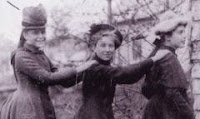DID PIONEERS WEAR UNDERWEAR? Fashion in the Old West by Cora Leland
The short answer is yes. Both women and men wore underwear, though on a wagon train, not pajamas. Throughout the nineteenth century, women dressed in layers: the minimum would have been a chemise (a kind of slip), a short or longer corset, a corset cover, petticoats and an overskirt.
In the West, this was reduced, for women in the rural areas, to chemise, petticoats and overdress, and sometimes a corset; but in 'civilization,' it was a different matter altogether. In the photo, it's hard to say where the models lived.
People who dressed 'fashionably' followed a wild pace of changes as to what constituted the latest look.
The pointed bodice (with guns)Also notice the tight sleeves.
Toward the close of the 1880's sleeves became looser.
Quite a bit more comfortable!
Various designs of a well-dressed woman's skirts were a cutaway skirt, a lifted top skirt (swooped skirt) and several others. Formal dresses could have more revealing necklines, but the rule for most women was a high, tight collar; as the century progressed, collars became still higher.
Alas, the bustle's importance emerged, then disappeared throughout the 1800's. Here is one medium-sized bustle (1880) for those times, when bustles were much smaller. Also, please notice her hairstyle: a gentle upswept style.
A bustle but a softer hair style (1880)
Although women were still expected to have very long hair, it was seldom worn down. When it was it was for art or illustrations. Girls were taught to wear their hair up when they were no older than eleven. The following hairstyles don't look as easy-going as the one with the bustle. Bangs were popular; late in the 1800's bangs were parted in the middle.
Also during the 1800's, hats were important.
Even a riding habit (left) had a matching hat (and the ladies on each side wore their hair down)
Toward the end of the century, the tall felt hat appeared for women.
But for pioneer women and women settlers and on wagon trains, hats were much simpler, if their lives dictated that: bonnets were pragmatic, for shading eyes and face from the blistering sun. Their frames were constructed from wood or wire.
And here we've come to the topic of dust.
Lots of dust in this logging town
A young woman who journeyed across the country cried out, as probably many others did as they trekked and rode in wagons on tracks that were ankle-deep in dust, "Oh, the dust, the dust! ... it was knee-deep in places. We came twenty miles without stopping.. the boys' faces were covered with all the dust...and I saw just the eyes, nose and mouth through the dust...How glad we all are to have clear cold water to wash away the dust."
One woman cried when she reached the end of her ten-day trip that she never enjoyed a bath so much as she did then.
Others complained that in this dusty world, their sun
bonnets were useless for keeping them safe. As happy as the traveler was about the clear cold water, authorities seem to be unanimous that bathing and even hand-washing didn't become accepted until the turn of the century.
From the Sun King Louis XIV to a San Francisco card-sharp, bathing was avoided for several reasons, including the ideas that bathing opened the skin to disease and underclothes made the body hygienic by absorbing perspiration and dirt. (Men often wore long underwear.)
People were, when they could afford it, careful of their outer garments: shirts, for example, which had high, tight collars among the fashionable. For everyone, body odor was considered perfectly normal.
Writing about cleanliness among plains residents, one authority stated that homesteaders grew so poor that they had one set of clothes at a time and simply never changed them until they'd become so ragged that the garments fell to pieces.
This expert claimed that deciding to come West was dangerous for one's health: no sewers, outhouses (until laws passed by towns) tipped to drain into the streets, mud streets with horses, no refrigeration and a poor, grease-laden diet -- and more. He did mention that Omaha, Nebraska, though no different from other places, was the healthiest city in the US.
Regarding soap: cowboys had been exposed to Mexican soap, which was made from a part of the yucca. That soap was gentle and sweet-smelling. Settlers, however, made soap and candles from animal fat, which was harsh and strong of scent.
Please notice the mud!Deadwood, Dakota Territory, 1800's
In any case, it's difficult not to be sympathetic when people lived in these conditions.
As you'd think, people going across country in wagon trains simply had no place to store more than three pieces of clothing for each person. They carried food and all supplies they'd need for months, some water, any furniture or possessions they'd need for setting up their new lives.
Even in those days, then, ladies sewed the family's clothes, for some, even their husband's shirts, and often they had to do without sewing machines. Some fabrics were imported from India, like cottons, so pioneers were accustomed to wear simpler fabrics. A popular one was linsey-woolsey. Laura Ingalls Wilder wrote in detail about a dress her heroine made of several yards cashmere, tucked and decorated.
Native Americans (known in those days simply as 'Indians') dressed in clothes hand-designed and sewed by women of the particular tribe they were born to and each traibe's designs varied.
Below is one drawing (by the Oglala holy man Black Road in 1880) titled 'Woman in a Red Wool Dress with Tepee." Next is a contemporary set of tribal 'dolls' showing the traditional clothes of the artist's tribe, including a parfleche (buffalo hide bag) and baby carrier.
Native American 'dolls' wearing traditional clothes













Thank you, Cora. Bath houses were popular when there was water to accommodate them.
ReplyDelete